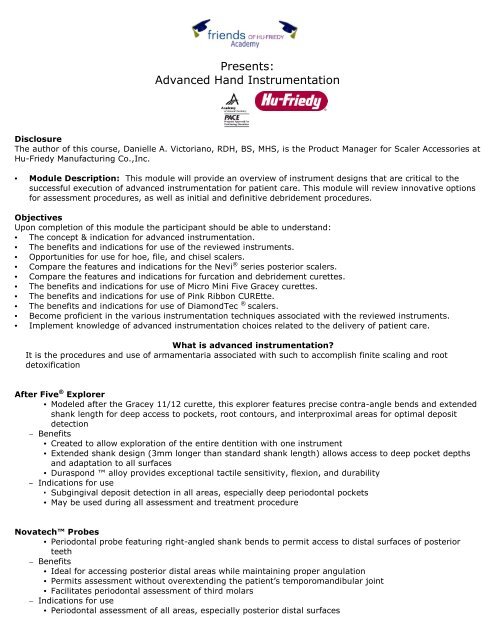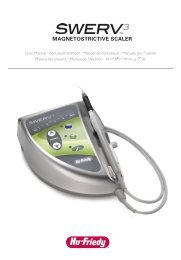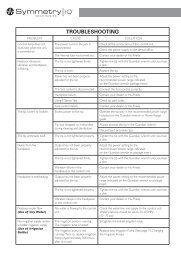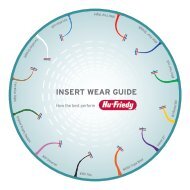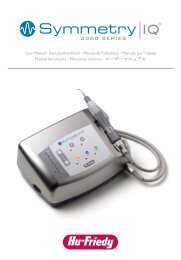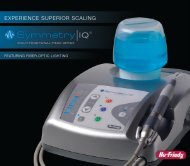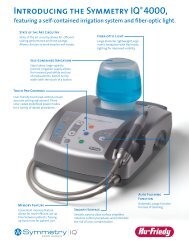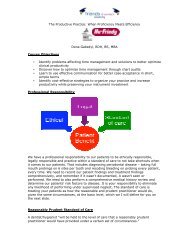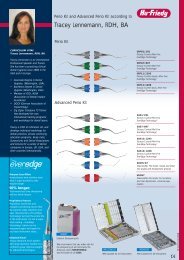Download the PDF COURSE NOTES HERE. - Friends of Hu-Friedy
Download the PDF COURSE NOTES HERE. - Friends of Hu-Friedy
Download the PDF COURSE NOTES HERE. - Friends of Hu-Friedy
Create successful ePaper yourself
Turn your PDF publications into a flip-book with our unique Google optimized e-Paper software.
Presents:<br />
Advanced Hand Instrumentation<br />
Disclosure<br />
The author <strong>of</strong> this course, Danielle A. Victoriano, RDH, BS, MHS, is <strong>the</strong> Product Manager for Scaler Accessories at<br />
<strong>Hu</strong>-<strong>Friedy</strong> Manufacturing Co.,Inc.<br />
• Module Description: This module will provide an overview <strong>of</strong> instrument designs that are critical to <strong>the</strong><br />
successful execution <strong>of</strong> advanced instrumentation for patient care. This module will review innovative options<br />
for assessment procedures, as well as initial and definitive debridement procedures.<br />
Objectives<br />
Upon completion <strong>of</strong> this module <strong>the</strong> participant should be able to understand:<br />
• The concept & indication for advanced instrumentation.<br />
• The benefits and indications for use <strong>of</strong> <strong>the</strong> reviewed instruments.<br />
• Opportunities for use for hoe, file, and chisel scalers.<br />
• Compare <strong>the</strong> features and indications for <strong>the</strong> Nevi ® series posterior scalers.<br />
• Compare <strong>the</strong> features and indications for furcation and debridement curettes.<br />
• The benefits and indications for use <strong>of</strong> Micro Mini Five Gracey curettes.<br />
• The benefits and indications for use <strong>of</strong> Pink Ribbon CUREtte.<br />
• The benefits and indications for use <strong>of</strong> DiamondTec ® scalers.<br />
• Become pr<strong>of</strong>icient in <strong>the</strong> various instrumentation techniques associated with <strong>the</strong> reviewed instruments.<br />
• Implement knowledge <strong>of</strong> advanced instrumentation choices related to <strong>the</strong> delivery <strong>of</strong> patient care.<br />
What is advanced instrumentation?<br />
It is <strong>the</strong> procedures and use <strong>of</strong> armamentaria associated with such to accomplish finite scaling and root<br />
detoxification<br />
After Five ® Explorer<br />
• Modeled after <strong>the</strong> Gracey 11/12 curette, this explorer features precise contra-angle bends and extended<br />
shank length for deep access to pockets, root contours, and interproximal areas for optimal deposit<br />
detection<br />
– Benefits<br />
• Created to allow exploration <strong>of</strong> <strong>the</strong> entire dentition with one instrument<br />
• Extended shank design (3mm longer than standard shank length) allows access to deep pocket depths<br />
and adaptation to all surfaces<br />
• Duraspond alloy provides exceptional tactile sensitivity, flexion, and durability<br />
– Indications for use<br />
• Subgingival deposit detection in all areas, especially deep periodontal pockets<br />
• May be used during all assessment and treatment procedure<br />
Novatech Probes<br />
• Periodontal probe featuring right-angled shank bends to permit access to distal surfaces <strong>of</strong> posterior<br />
teeth<br />
– Benefits<br />
• Ideal for accessing posterior distal areas while maintaining proper angulation<br />
• Permits assessment without overextending <strong>the</strong> patient’s temporomandibular joint<br />
• Facilitates periodontal assessment <strong>of</strong> third molars<br />
– Indications for use<br />
• Periodontal assessment <strong>of</strong> all areas, especially posterior distal surfaces
Hoe Scalers<br />
• Instruments that features a straight, thick cutting edge with a beveled tip angled at 45°<br />
– Benefits<br />
• Ideal for areas <strong>of</strong> easy access and boggy tissue to fracture spicules and ledges <strong>of</strong> supragingival deposits<br />
• Varying degrees <strong>of</strong> shank length and bends provide area specific access<br />
– More angled, longer shanks—ideal for posterior areas<br />
– Less angled, shorter shanks—ideal for anterior areas<br />
– Indications for use<br />
• For removing heavy supragingival calculus<br />
• Pull strokes are used to activate stroke<br />
Chisel Scalers<br />
• This instrument is available with a straight or curved shank, and its blade is continuous with <strong>the</strong> shank.<br />
• This instrument features very sharp corners at each end <strong>of</strong> <strong>the</strong> blade.<br />
• Its narrow cutting edge is formed with <strong>the</strong> tip beveled at a 45 ° angle.<br />
– Benefits<br />
• Excellent at fracturing large ledges <strong>of</strong> supragingival calculus from mandibular anterior teeth.<br />
– Indications for use<br />
• Push strokes are used during activation with a modified pen grasp.<br />
• Used to fracture and remove heavy interproximal, facial and lingual calculus from mandibular anterior<br />
teeth.<br />
File Scalers<br />
• Used subgingivally and supragingivally to crush and fracture heavy deposits<br />
• This instrument features a series <strong>of</strong> miniature hoe blades on a foundation base, attached to a shank <strong>of</strong><br />
varying angulations and lengths<br />
– The base shape is variable also<br />
• Each miniature hoe blade is angled at 90 -105 degrees from <strong>the</strong> shank<br />
– Benefits<br />
• Rigid shanks for easier deposit removal<br />
• Area-specific designs for mesial, distal, facial, and lingual surfaces<br />
• Deposits are approached from a facial or lingual orientation<br />
– Indications for use<br />
• Pull strokes are used with a modified pen grasp during activation<br />
• May be used subgingivally or supragingivally to crush deposits<br />
DiamondTec file scalers<br />
• 365 degree diamond-coated file scalers for accessing root concavities, developmental grooves,<br />
furcations, and line angles<br />
– Benefits<br />
• Full coverage diamond coating<br />
• Curved shank bends to facilitate furcation and interproximal access<br />
• Ergonomic handle dimensions for increased comfort and control<br />
– Indications for use<br />
• Used with horizontal, vertical and oblique stroke patterns in a push/pull motion<br />
• All surfaces may be utilized, depending on area <strong>of</strong> access and clinician’s preference<br />
• Intraoral and extraoral fulcrums may be utilized<br />
Nevi ® Series <strong>of</strong> Posterior Scalers<br />
– With slender, tapered blades and precise contra-angle bends, partnered with revolutionary EverEdge ®<br />
Technology, <strong>the</strong> Nevi series <strong>of</strong> posterior sickle scalers provides solutions for all <strong>of</strong> <strong>the</strong> toughest scaling<br />
needs.<br />
SCNEVI39 (Nevi 3) Benefits<br />
• Ultra slender dual cutting blades provide:<br />
– Effective placement in tight, narrow contacts and interproximal areas<br />
– Precise access for effective removal <strong>of</strong> light to moderate deposits<br />
– EverEdge ® Technology makes blades stay sharper longer<br />
• Unique contra-angle bends provide:<br />
– Superior access, reach and adaptation to posterior areas
SCNEVI49 (Nevi 4) Benefits<br />
• Tapered dual cutting blades provide:<br />
– Precise access for effective deposit removal<br />
– Makes quick work <strong>of</strong> <strong>the</strong> toughest scaling tasks<br />
– EverEdge ® Technology makes blades stay sharper longer<br />
• Increased shank rigidity provides:<br />
– Powerfully effective strokes with less effort and fatigue for <strong>the</strong> clinician<br />
– Especially effective for removal <strong>of</strong> burnished, heavy, and tenacious deposits<br />
Nevi® Series <strong>of</strong> Posterior Scalers<br />
– Indications for use<br />
• Supragingival scaling in posterior applications<br />
• For light to moderate deposits: Nevi 3, SCNEVI39<br />
• For moderate to heavy and burnished deposits: Nevi 4, SCNEVI49<br />
Seeing is believing!<br />
Nevi 3 and Nevi 4 adapting to posterior sextants<br />
(View video on <strong>Friends</strong> <strong>of</strong> <strong>Hu</strong>-<strong>Friedy</strong>’s Multimedia Section)<br />
Furcation & Debridement Curettes<br />
– Curettes designed to detoxify and smooth root and furcation anatomy<br />
– Abrasive/ textured surfaces: Furcation<br />
– 365 degree cutting edges on a discoid base: Debridement<br />
– Benefits<br />
• Provides precise access to furcations and concavities for root surface detoxification<br />
– Indications for use<br />
• Pull strokes are used during activation<br />
• Internal or external fulcrums may be utilized<br />
• Stroke sequence is very similar to file scalers<br />
SYME9, Pink Ribbon CUREtte<br />
– An area-specific curette with a single cutting edge that is 70° in relation to <strong>the</strong> terminal shank<br />
• This instrument features a contra-angle shank design that provides optimal tooth-to-blade angulation<br />
– Benefits<br />
• Ideal for <strong>the</strong> needs <strong>of</strong> maintenance patients<br />
• A donation is made to <strong>the</strong> Breast Cancer Network <strong>of</strong> Strength (formerly <strong>the</strong> Y-ME National Breast<br />
Cancer Organization) with <strong>the</strong> sale <strong>of</strong> each curette<br />
– Indications for use<br />
• Ideal for subgingival and supragingival applications for anterior and premolar areas, as well as<br />
pedodontic dentition<br />
• Pull stroke is used during activation with intraoral and extraoral fulcrums<br />
Micro Mini Five Gracey Curettes<br />
• Benefits<br />
– Ultra slender blades<br />
– Increased shank strength for precise deposit removal<br />
– Excellent applications for instrumentation <strong>of</strong> root line angles, narrow anterior pockets, furcations, and root<br />
concavities (depressions).<br />
– Perfect for <strong>the</strong> most challenging periodontal pockets<br />
– Similar to traditional Mini Five Gracey curettes<br />
• An extended shank length<br />
• Reduced blade length<br />
• Precise bends<br />
• Indications for use<br />
– For fine deposit removal following first stage root and tooth debridement<br />
– Pull stroke used during activation<br />
– Intraoral and extraoral fulcrums may be utilized
Video clip <strong>of</strong> Micro Mini Five Graceys in action in various applications throughout <strong>the</strong> mouth<br />
(View video on <strong>Friends</strong> <strong>of</strong> <strong>Hu</strong>-<strong>Friedy</strong>’s Multimedia Section)<br />
Video Clip <strong>of</strong> Furcation Instrumentation on a typodont accessing molar anatomy!<br />
(View video on <strong>Friends</strong> <strong>of</strong> <strong>Hu</strong>-<strong>Friedy</strong>’s Multimedia Section)<br />
Video Clip <strong>of</strong> Furcation instrumentation on an extracted molar!<br />
(View video on <strong>Friends</strong> <strong>of</strong> <strong>Hu</strong>-<strong>Friedy</strong>’s Multimedia Section)<br />
• Note how <strong>the</strong> SMS11/129 is utilized to instrument <strong>the</strong> mesial aspect <strong>of</strong> <strong>the</strong> distal root<br />
• Note how <strong>the</strong> SMS13/14 is utilized to access <strong>the</strong> distal aspect <strong>of</strong> mesial root<br />
• There are many options available to enable <strong>the</strong> clinician to perform intermediate to advanced instrumentation<br />
for pr<strong>of</strong>ound clinical results and outcomes.<br />
• In each scenario, <strong>the</strong> clinician should evaluate <strong>the</strong> treatment needs to choose and implement <strong>the</strong> appropriate<br />
instrument to best achieve <strong>the</strong> desired outcomes.<br />
About <strong>the</strong> author<br />
Danielle Victoriano is a Registered Dental Hygienist, with over 13 years <strong>of</strong> clinical experience and 8 years <strong>of</strong><br />
dental hygiene education. Danielle holds Associate and Bachelor <strong>of</strong> Science degrees in Dental Hygiene from<br />
LSUHSC School <strong>of</strong> Dentistry in New Orleans, as well as a Master <strong>of</strong> Health Sciences in Dental Hygiene, with an<br />
Education focus, from LSUHSC School for Allied Health Pr<strong>of</strong>essions. Her area <strong>of</strong> <strong>the</strong>sis study was distance<br />
education and dental hygiene programs.<br />
Danielle served as an Assistant Pr<strong>of</strong>essor <strong>of</strong> Clinical Dental Hygiene and 1st Year Clinical Coordinator at<br />
LSUHSC School <strong>of</strong> Dentistry in New Orleans, LA, and <strong>the</strong> 2nd Year Clinical Coordinator at Kennedy-King<br />
College/UIC College <strong>of</strong> Dentistry Dental Hygiene Program in Chicago, IL. Areas <strong>of</strong> instruction during her tenure<br />
included instrumentation, sharpening, dental materials, clinical instruction, and pr<strong>of</strong>essional development.<br />
She may be reached via email: dvictoriano@hu-friedy.com.<br />
CE Accreditation<br />
Course Provider: <strong>Hu</strong>-<strong>Friedy</strong><br />
<strong>Hu</strong>-<strong>Friedy</strong> is an Academy <strong>of</strong> General Dentistry approved PACE Program Provider. FAGD/MAGD Credit. Approval<br />
does not imply acceptance by a state or provincial board <strong>of</strong> dentistry or AGD endorsement. #218966 (June 1,<br />
2008 - May 31, 2011).<br />
This activity has been planned and implemented in accordance with <strong>the</strong> standards <strong>of</strong> <strong>the</strong> AGD PACE through<br />
<strong>Hu</strong>-<strong>Friedy</strong> Manufacturing Co; 3232 N. Rockwell St., Chicago, Ill. 60618; Phone #773-975-6100<br />
This presentation provides 1 CEU<br />
Please take <strong>the</strong> post-test to earn your CE credit


